Figures & data
Figure 1. UNC5b is expressed in epidermal stem cells (ESCs). (A) RT-PCR analysis revealed that UNC5b is expressed in ESCs; (B) Western blot analysis revealed that UNC5b is expressed in ESCs. RAW264.7 cells were used as a positive control. Experiments were performed in triplicate.

Figure 2. Expression of UNC5b is increased in response to exposure to ultraviolet-B (UV-B) in ESCs. ESCs were exposed to UV-B at the intensity of 25–75 mJ/cm2 for 8 h. (A) Expression of UNC5b at the gene level was determined by real-time PCR analysis; (B) Expression of UNC5b at the protein level was determined by western blot analysis (ANOVA:*, #, $, p < .001 vs previous column group, n = 4–5).

Figure 3. The UNC5b agonist netrin-1 attenuates ultraviolet-B (UV-B) exposure-induced oxidative stress in ESCs. ESCs were preincubated with netrin-1 (200, 400 ng/ml) for 12 h, followed by treatment with UV-B at 50 mJ/cm2 for 8 h. (A) Intracellular ROS was determined by DCFH-DA; Scale bar, 100 μM; (B) Western blot analysis of NOX-4 (ANOVA:*, #, $, p < .001 vs previous column group, n = 4–5).
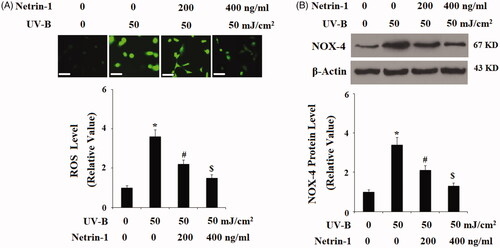
Figure 4. The UNC5b agonist netrin-1 protected ESCs against ultraviolet-B (UV-B) exposure-induced mitochondrial dysfunction. ESCs were preincubated with netrin-1 (200, 400 ng/ml) for 12 h, followed by treatment with UV-B at 50 mJ/cm2 for 8 h. (A) Mitochondrial membrane potential (MMP) determined by tetramethylrhodamine methyl ester (TMRM) staining; Scale bar, 100 μM; (B) Intracellular levels of Adenosine triphosphate (ATP) determined by the bioluminescence assay (ANOVA:*, #, $, p < .001 vs previous column group, n = 4–5).
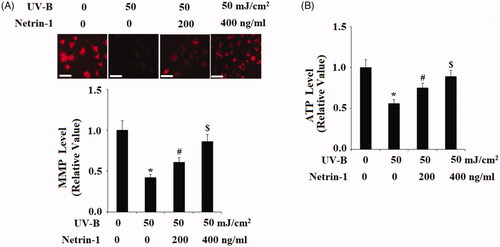
Figure 5. The UNC5b agonist netrin-1 protected ESCs against ultraviolet-B (UV-B) exposure-induced LDH release. ESCs were preincubated with netrin-1 (200, 400 ng/ml) for 12 h, followed by treatment with UV-B at 50 mJ/cm2 for 8 h. LDH release was determined by a commercial kit (ANOVA:*, #, $, p < .001 vs previous column group, n = 5).
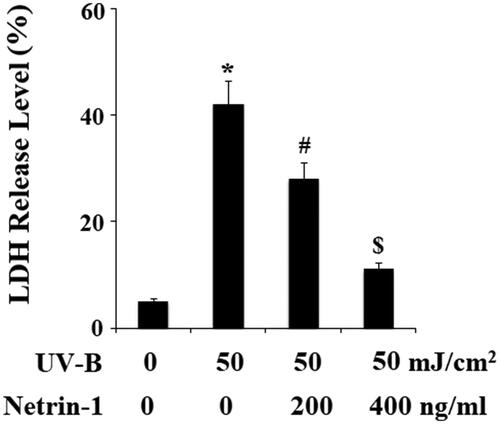
Figure 6. The UNC5b agonist netrin-1 prevented ultraviolet-B (UV-B) exposure-induced reduced cell viability. ESCs were preincubated with netrin-1 (200, 400 ng/ml) for 12 h, followed by treatment with UV-B at 50 mJ/cm2 for 8 h. Cell viability was determined by MTT assay (ANOVA:*, #, $, p < .001 vs previous column group, n = 5).
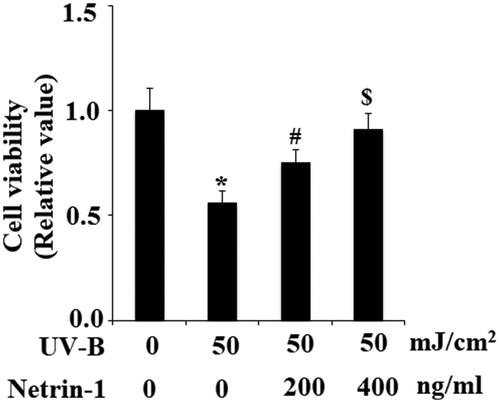
Figure 7. The UNC5b agonist netrin-1 prevented ultraviolet-B (UV-B) exposure-induced impairment in the capacities of ESCs. ESCs were preincubated with netrin-1 (200, 400 ng/ml) for 12 h, followed by treatment with UV-B at 50 mJ/cm2 for 8 h. Expression of integrin β1 and Krt19 at the gene level was determined by real-time PCR analysis (ANOVA:*, #, $, p < .001 vs previous column group, n = 4–5).
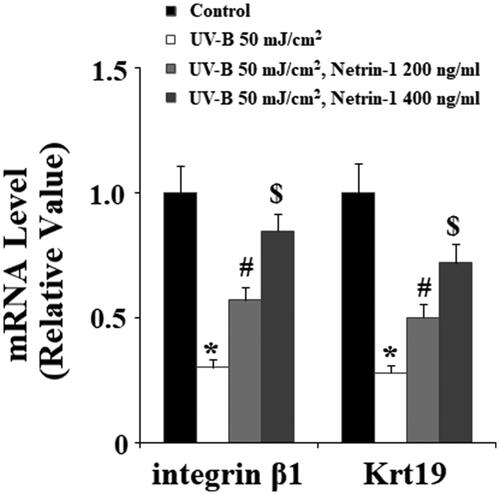
Figure 8. Knockdown of UNC5b abolished the protective effects of netrin-1 against ultraviolet-B (UV-B) exposure-induced impairment in the capacities of ESCs. ESCs were infected with lentiviral UNC5b shRNA. Cells were pre-incubated with netrin-1 (200, 400 ng/ml) for 12 h, followed by treatment with UV-B at 50 mJ/cm2 for 8 h. (A) Western blot analysis revealed the successful knockdown of UNC5b; (B) Real-time PCR analysis showed that knockdown of UNC5b abolished the effects of netrin-1 in integrin β1 and Krt19 expressions (ANOVA:*, #, $, p < .001 vs previous column group, n = 4–5).

Figure 9. The UNC5b agonist netrin-1 ameliorated ultraviolet-B (UV-B)-induced reduced Wnt pathway proteins. Cells were pre-incubated with netrin-1 (200, 400 ng/ml) for 12 h, followed by treatment with UV-B at 50 mJ/cm2 for 8 h. (A) Real-time PCR analysis of Wnt1, Wnt3a, Myc, cyclin D1; (B) Western blot analysis of Wnt1, Wnt3a, Myc, cyclin D1 (ANOVA:*, #, $, p < .001 vs previous column group, n = 4–5).

